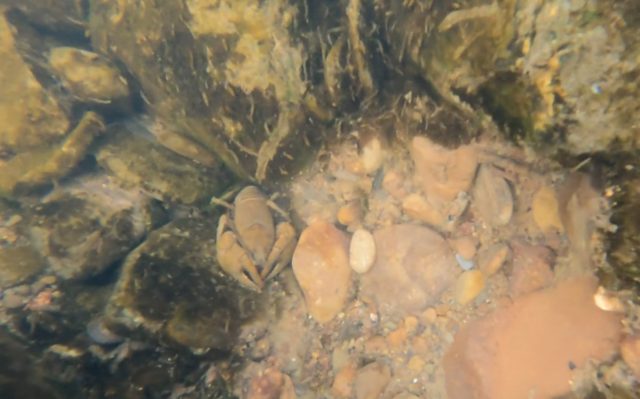COLUMBUS, Ohio- Ohio Department of Natural Resources Director Mary Mertz today provided an updated estimate on the number of minnows potentially killed as a result of the train derailment in East Palestine.
The final sample count of aquatic species killed in waterways impacted in the area totaled 2,938. Of this collected sample, most – nearly 2,200 – were small minnows.
Based on this sample count, ODNR used a calculation endorsed by the American Fisheries Society to estimate the total number of minnows killed in the entire 5-mile span of waterway from the derailment site to the point where Bull Creek flows into the north fork of Little Beaver Creek. Of the estimate, 38,222 were minnows, ranging in size between 1 and 3 inches.
ODNR also estimated the total number of other aquatic life killed as a result of the derailment, including small fish, crayfish, amphibians, and macroinvertebrates. This number is approximately 5,500.
Although dead aquatic species still remain in the impacted waterways, the entirety of the impact to the aquatic life is believed to have occurred in the first 24-hours after the derailment. There is no immediate threat to minnows, fish, or other aquatic species – in fact, live fish have returned to Leslie Run.
None of the species killed are believed to be endangered or threatened.
A recording of today’s virtual meeting can be found here. Other resources available are as follows:
- Map of aquatic species collection stations
- Video of living aquatic species after the derailment labeled by location.
ODNR Director Mary Mertz provided the following statement:
“Today, I’d like to give you an update on the status of aquatic life in the waterways near the derailment site, but let me first give you some background:
The morning after the train derailment in East Palestine, ODNR Wildlife personnel and officers responded to survey the waterways to determine the impact of the chemical spill on aquatic life. Upon arrival, the Ohio EPA advised our teams that it was too dangerous to enter the water without specialized gear and equipment.
In response, ODNR requested the help of an environmental consulting firm that was already on site working to contain the spill. Under the direction of the Division of Wildlife, EnviroScience, which had the appropriate equipment and protection, proceeded to use our standard methodology to survey the waterways for dead aquatic species.
Procedures for fish kill investigations over a watershed are based on science. These scientific methods include the collection of data and specimens as soon as possible, which is what happened. Four collection stations were established to gather necessary data, in this case dead aquatic species.
We had 2-3 officers monitoring that collection since it began. Dead fish were collected in the four designated survey spots by entering the water and using a net. Following collection, EnviroScience counted, identified, measured, and arranged disposal of the aquatic species to limit impact to other wildlife that might feed on affected aquatic species.
This collection occurred over two days, on February 6th and 7th.
We have previously reported approximately 3500 dead aquatic species, comprised primarily of minnows and small fish, were observed. That estimate was based on visual observation of the species collected over the two-day period.
Once all of the actual data was collected from the various survey sites and the information was organized, that number was modified to a confirmed total of 2938 aquatic species – this is less than the initial estimate.
Of this sample, 2,200 (or around 75%) were 1-to-3-inch minnows. The other 25% included other small fish, crayfish, amphibians, and macroinvertebrates.
After receiving that final sample number of collected dead aquatic species, ODNR wildlife investigators next applied a science-based calculation endorsed by the American Fisheries Society to that number to determine the estimated total number of dead aquatic species, including those likely still in the water.
So, again – we have the sample number of collected species, and we have to use a calculation to determine the total estimated number.
This new calculation estimates that a total of 38,222 minnows were potentially killed as a result of the derailment.
It is estimated that a total of around 5,500 other species – again, things like small fish, crayfish, amphibians and macroinvertebrates, were also potentially killed as a result of the derailment.
Since then, additional work has been completed to remove more dead fish from the water, although that removal is not part of the survey.
The investigation has thus far concluded that of the 7-and-a-half-mile impacted area, the species were killed over a 5-mile span. This area of impact runs from the train derailment site near Sulphur Run to where Bull Creek flows into the North Fork of Little Beaver Creek.
In the days that followed, officers searched beyond the impacted waterways, checking the Ohio River down through Jefferson County and at the Cumberland lock and dam. They did not observe any dead aquatic life.
And, it’s important to stress that these small fish are all believed to have been killed immediately after the derailment. Because the chemicals were contained, ODNR has not seen any additional signs of aquatic life suffering in the streams. In fact, we have seen live fish return to Leslie Run.
ODNR continues to believe that none of the species killed in this event are in the threatened or endangered category. We are awaiting test results of several non-aquatic animals including three birds, and an opossum. We do not believe any of these animals were made sick by the train derailment, but we have submitted those specimens to the Ohio Department of Agriculture and will wait for those test results before making that judgement.
We are continuing to monitor and assess the environmental impact during cleanup.”
There are resources available for those living in East Palestine. Visit ema.ohio.gov/eastpalestine for more information.











